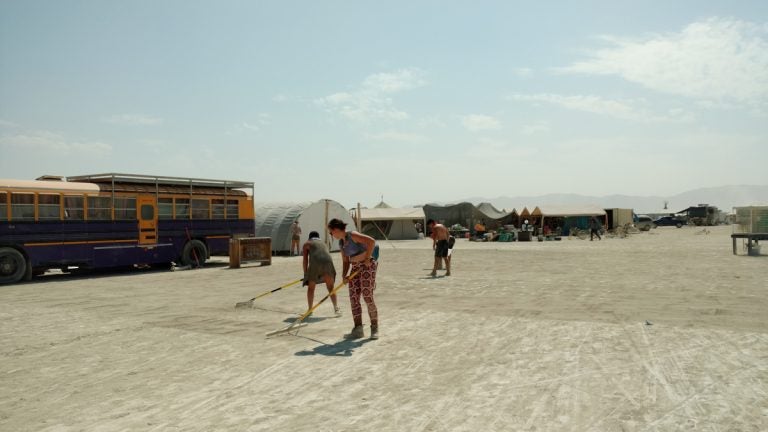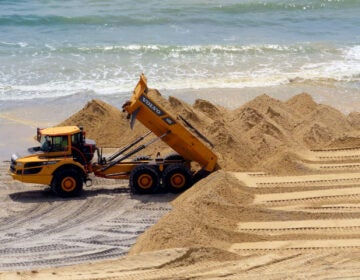How does Burning Man leave the desert squeaky clean?
70,000 people, nine days in the Nevada desert, and zero trash.
Listen 0:00
Members of camp 'License to Chill' cleaning up their site on the second to last day of the event. (Andrew Stelzer/for WHYY)
It’s the second to last day of Burning Man, the festival’s signature 50-foot high wooden man went up in flames last night, and thousands of people are packing up to go home, but not Evan Schmidt. He and a group of friends are bent over, scanning the desert floor and raking the dusty ground.
Until this morning, this is where Camp License to Chill — a group of 20 from Seattle — was set up.
“We serve sno-cones and have sort of just a general lounge space,” he says.
Most people at Burning Man name their group, and offer some sort of service or entertainment to the public. It’s called a “theme camp.”
“We’d have just hundreds of people coming through,” Schmidt said. “And as much as everyone tries, little bits get dropped, you end up with little bits of wrappers and bottle caps.”
Guess what these folks spend most of their time picking up?
“The biggest thing is hair,” Schmidt says.
Yup. Hair.
These people are standing around in 102-degree mid-day heat, raking the desert floor, in search of stray hairs.
Extreme clean
With 70,000 people, over a thousand open bars, and hundreds of giant fires, the annual Burning Man gathering sounds like a recipe for a mess. But guess how many garbage cans are provided? Zero.
Most attendees pay between $200 and $400 for a ticket and then spend hours cleaning up after themselves and their neighbors.
Ingrid Porter is holding a small plastic baggie with pieces of string, cigarette ash, even natural stuff like pine needles. Because of the dry air and lack of bacteria in the barren desert, nothing biodegrades out here.
“I’ve definitely seen a lot of people who carry bags around with them all week, not even just toward the end, but all week, to make sure that we’re really leaving no trace,” she says.
“Leaving No Trace” is one of the 10 official principles of Burning Man, and it’s part of the cultural ethic passed on by “burners” — people who come back here year after year.
Sarah Urban from Las Vegas is a first time burner. But she had a veteran friend who ‘schooled’ her. They spent part of the week cleaning up the “playa”— that’s the scientific name for the alkali flats in Nevada’s Black Rock Desert.
“You pick up your crap, and if you see anything, anybody else’s, you pick that up, too.” Urban says.
They found a bike pump, ropes and zip ties among other things.
“But the weirdest thing,” says Urban. “Somebody mooped a bra on top of our car.”

MOOP, there it is
Urban’s using a bit of Burning Man lingo there: MOOP. M-O-O-P stands for Matter Out Of Place. It basically means trash. If you’re “mooping,” that means you’re picking up MOOP.
After the event is over, a crew of about 150 people, a mix of paid staff and volunteers stick around for weeks, scouring the desert, doing line sweeps in human chains, picking up anything that was left behind — because even campers who try hard are bound to miss some MOOP.
“The little things are hard, and that’s just a given,” said Dominic Tinio, who goes by “D.A.” He works for the Burning Man organization as head of the playa restoration team.
“It’s not like we have this event on a hardwood floor and we just sweep up all the MOOP,” Tinio said. “If that was the case, this place would be spotless. But no, we’re in the Black Rock Desert.”
Out on this flat windy expanse, only seconds after you drop something, it might be obscured by a dust storm, or blowing away in the wind. There’s glitter, sequins, and cigarette butts. But Tinio says these days, “the most number one common form of MOOP is actually wood.”
Wood shavings from art projects. Slivers of firewood logs that have been thrown on the ground in a big pile.
“Wood will stop my crew dead in its tracks,” says Tinio. “And we will get down on our hands and knees and pick up that wood.”
A bunch of wood also means that area gets marked red on the MOOP map. Tinio invented the map back in 2006, as a way to track how Burning Man “residents” leave their area.
“I’m a graphic designer previously in a former lifetime, so I understand things visually,”he says.

The map has three colors: red, yellow and green. Green is the best, meaning the restoration crew breezed through, finding a minimum of trash. Yellow means it wasn’t so easy. Red is bad.
During the restoration process, the team blogs daily about how things went and colors in the map online. Back at home, burners eagerly wait to see what color their camp was awarded.
“We want it to be like you’re following your favorite sports team'” says Tinio. “We wanted to give the community something to cheer for.”
He says shaming isn’t part of the process, but there are potential consequences. If the space where you camped shows up ‘scarlet’ red on the map, your group may not get assigned a prime location next year.
In 2016, camp License to Chill was green, and this year, they got placed a little bit closer to the center of the pop-up city. That’s one reason Patrick Foye is pushing what looks like an old fashioned lawnmower across the dusty ground.
“I’m just driving this little rolling magnet around picking up any loose shavings or screws,” Foye says.
We hear a “clink” sound.
“Looks like bolt!” Foye says.
Clean up or clear out
Camp License to Chill wants an even better spot next year; and they want to do the right thing, of course. But for Burning Man, cleaning up the desert is a matter of survival. The event is held on federal land, and overseen by the Bureau of Land Management.
“The standard is that they can’t leave more than one square foot of ‘MOOP’ per acre,” says Dave Cooper, who used to work for the bureau.
“They have to meet that standard or it will jeopardize their permit in the next year,” he explains.
About a month after Burning Man is over, inspectors from Bureau of Land Management come in and randomly sample 60 plots, each a tenth of an acre in size.

“Burning Man has become a master in how to clean up a site after a large event like this,” says Cooper, who’s now retired and has become a burner himself.
Cooper camps with a group called the Earth Guardians. They hold lectures and conduct nature tours. He also leads a champagne MOOP train run every day at 11 a.m.
“We drink champagne and then pick up trash … make sure that it doesn’t escape and get away,” says Cooper as he shows off his yellow vehicle with red flames painted on the sides.
“Doing our part to keep Black Rock City clean!”
WHYY is your source for fact-based, in-depth journalism and information. As a nonprofit organization, we rely on financial support from readers like you. Please give today.






